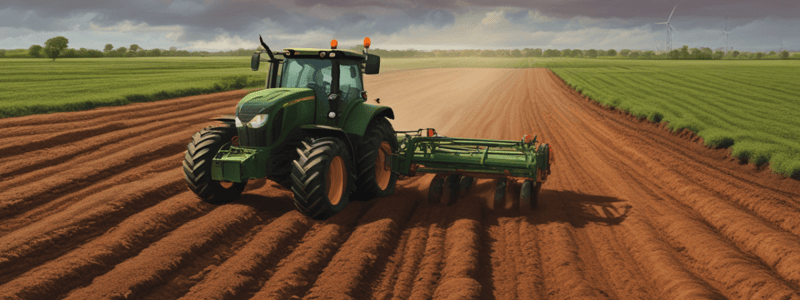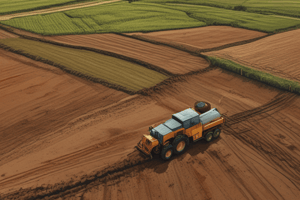Podcast
Questions and Answers
What are the three key elements essential for plant growth and life cycle, and what are their symbols?
What are the three key elements essential for plant growth and life cycle, and what are their symbols?
Carbon (C), Hydrogen (H), and Oxygen (O)
What are the two categories of essential elements for plant growth, and what are some examples of each?
What are the two categories of essential elements for plant growth, and what are some examples of each?
Macronutrients (e.g. Nitrogen, Phosphorous, Potassium) and Micronutrients (e.g. Iron, Zinc, Manganese)
What are the effects of Nitrogen deficiency in plants, and what are some signs of Nitrogen deficiency?
What are the effects of Nitrogen deficiency in plants, and what are some signs of Nitrogen deficiency?
Slow growth, pale green or yellow leaves, and necrosis in older leaves
What is lodging in cereal crops, and how can it be prevented or minimized?
What is lodging in cereal crops, and how can it be prevented or minimized?
What are the benefits of good soil management in arable and livestock farming?
What are the benefits of good soil management in arable and livestock farming?
What is the role of calcium in plants?
What is the role of calcium in plants?
What is the ideal pH range for nutrient availability in soil?
What is the ideal pH range for nutrient availability in soil?
What is the purpose of soil testing?
What is the purpose of soil testing?
What is the difference between a straight fertilizer and a compound fertilizer?
What is the difference between a straight fertilizer and a compound fertilizer?
What is the advantage of using CAN (Calcium Ammonium Nitrate) as a fertilizer?
What is the advantage of using CAN (Calcium Ammonium Nitrate) as a fertilizer?
What is the disadvantage of using urea as a fertilizer?
What is the disadvantage of using urea as a fertilizer?
What is the difference between permanent pastures used for grazing and those used for silage production?
What is the difference between permanent pastures used for grazing and those used for silage production?
What is the ideal weather condition for spreading slurry to reduce emissions and protect the environment?
What is the ideal weather condition for spreading slurry to reduce emissions and protect the environment?
How does soil type affect soil drainage?
How does soil type affect soil drainage?
What is the benefit of soil drainage in terms of livestock grazing?
What is the benefit of soil drainage in terms of livestock grazing?
What is the definition of eutrophication?
What is the definition of eutrophication?
What is the unit of measurement for Biological Oxygen Demand (BOD)?
What is the unit of measurement for Biological Oxygen Demand (BOD)?
What is the goal of conservation in sustainable land use?
What is the goal of conservation in sustainable land use?
What is the effect of earthworms on soil structure?
What is the effect of earthworms on soil structure?
When should fertiliser and slurry not be spread on land?
When should fertiliser and slurry not be spread on land?
What is the purpose of nutrient management programmes in conservation?
What is the purpose of nutrient management programmes in conservation?
How does soil drainage affect crop yields?
How does soil drainage affect crop yields?
What are the hazards associated with ammonium in the atmosphere, especially at ground level?
What are the hazards associated with ammonium in the atmosphere, especially at ground level?
Why is it recommended to avoid spreading urea fertiliser during warm and dry weather?
Why is it recommended to avoid spreading urea fertiliser during warm and dry weather?
What is the purpose of wearing goggles, gloves, and overalls when handling fertilisers?
What is the purpose of wearing goggles, gloves, and overalls when handling fertilisers?
What is the advantage of using pig slurry over cattle slurry for grazed swards?
What is the advantage of using pig slurry over cattle slurry for grazed swards?
What is the benefit of spreading pig or cattle slurry on the land in terms of soil fertility?
What is the benefit of spreading pig or cattle slurry on the land in terms of soil fertility?
Why is it necessary to agitate slurry tanks with proper ventilation?
Why is it necessary to agitate slurry tanks with proper ventilation?
What is the difference in the application method of FYM and slurry on land?
What is the difference in the application method of FYM and slurry on land?
How does FYM affect soil structure compared to slurry?
How does FYM affect soil structure compared to slurry?
What is the difference in the release of nutrients between FYM and slurry?
What is the difference in the release of nutrients between FYM and slurry?
What factor affects the composition of slurry?
What factor affects the composition of slurry?
Flashcards are hidden until you start studying
Study Notes
Soil Management Principles
- Good management is critical for successful crop and livestock production, and good soil management is a key component.
- Soil provides a medium for crop growth, grassland, and good quality winter fodder.
- Good soil management can reduce the threat of disease and contain deficiency diseases.
Soil Health and Fertility
- 17 essential elements are crucial for plant growth and life cycle.
- 3 key elements are Carbon (C), Hydrogen (H), and Oxygen (O).
- Remaining 14 elements are classified as Macro and Micronutrients.
Macronutrients
- Nitrogen (N) is needed for:
- Photosynthesis (Chlorophyll)
- Protein Production (Amino Acids)
- Growth (DNA)
- Reproduction in Plants
- Sufficient Nitrogen:
- Rapid plant growth
- High protein content in seeds
- Dark green vegetation
- Nitrogen Deficiency:
- Slow Growth - small plants
- Pale green/ yellow due to lack of chlorophyll
- Necrosis (death) in older leaves
- Phosphorus (P) is needed for:
- Growth and Reproduction
- Production of new cells
- Seed formation and development
- Transfer DNA to new cells
- Soluble in water
- Sufficient Phosphorus:
- Vigorous growth
- Early Maturing
- Increased Resistance to Plant disease
- Phosphorus Deficiency:
- Stunted growth
- Lack of fruit or flowers
- Wilting
- Reducing P leaching:
- Create buffer or riparian zones around water sources
- Correct application rates to prevent excess P in soil
- Cover crops to absorb excess P and prevent run off
- Apply P at correct time
Potassium (P) is needed for:
- Protein synthesis
- Translocation of carbohydrates
- Activation of plants enzymes
- Promotion of disease resistance
- Regulation of plant stomata and water use
- Sufficient Potassium:
- Increased crop yields
- Increased root growth
- Potassium Deficiency:
- Reduced Crop yield
- Chlorosis of leaves
- Slow growth
Lodging
- Lodging: the tendency of cereal crops to bend over, making it difficult to harvest and reduce yield.
- Macronutrient:
- Calcium: needed in cell wall formation
- Magnesium: part of the chlorophyll molecule
- Sulfur: contained in amino acids for protein
Micronutrients
- Iron: synthesis of chlorophyll
- Zinc: crop resistance against drought
- Manganese: synthesis of chlorophyll
- Copper: transport systems in photosynthesis
- Boron: forming and strengthening cell wall
- Molybdenum: catalyzes key steps of nitrogen, carbon, and sulfur metabolisms
Nutrient Availability in Soil
- Most nutrients are available between pH 6 and 7
- Soil testing allows farmers to determine nutrients available in their land and determine suitability for crop growth.
Fertilizers and Manures
- Fertilizers: inorganic, manufactured materials that contain one or more essential elements
- Manure: organic material that consists of plant and animal wastes
- Examples of fertilizers:
- Urea: N (46%)
- CAN (Calcium Ammonium Nitrate): N (27.5%)
- Sulfate of ammonia: N (21%)
- Ground rock phosphate: P (12%)
- Superphosphate: P (7%)
- Triple superphosphate: P (16%)
- Muriate of potash: K (50%)
- Sulfate of potash: K (42%)
Fertiliser Application
- May be applied by:
- Placing in the soil
- Broadcasting
- Top dressing
Farm Yard Manure (FYM)
- FYM consists of animal dung, animal urine, and straw from winter bedding
- As it decomposes, it releases nutrients
- Contributes to organic matter in soil
Slurry
- Slurry is liquid manure that contains animal dung and urine
- Collected in tanks in slatted houses
- Contains less organic matter than manure due to no straw
- Absorbs quickly as it's liquid
- Faster growth
- Can contribute to weed dispersal
Hazards and Risks
- CAN: oxidizing, can cause combustion of other materials
- UREA: volatilization of fertiliser, toxic chemicals
- Wear goggles, gloves, and overalls to protect skin and respiratory system
- Handle bags carefully to avoid damage
- Store same type of fertilisers together
Soil Drainage
- Soil drainage can be affected by several factors:
- Soil type
- Percolation
- Precipitation
- Groundwater
- Types of drainage:
- Ground Water
- Shallow Water
- Benefits of soil drainage:
- Less poaching of land by livestock
- Extended grazing season
- Increased crop yields
- Greater window of opportunity available for tillage operations
Conservation
- Protection and wise management of earth's resources so they can be used for future generations
- Good management practices for sustainable land use
- Examples:
- Spreading Fertiliser and Nitrates regulations
- Crop rotation
- Soil testing
- Minimum tillage or no-till
- Drainage of land
- Encourage biodiversity
- Nutrient management programmes
- Irrigation of land
- Protection of beneficial organisms – earthworm
Studying That Suits You
Use AI to generate personalized quizzes and flashcards to suit your learning preferences.




